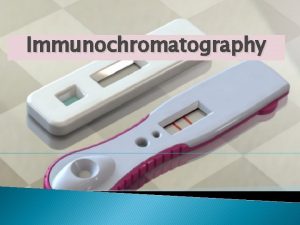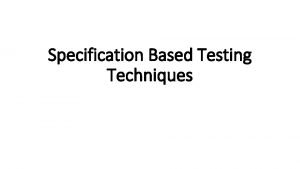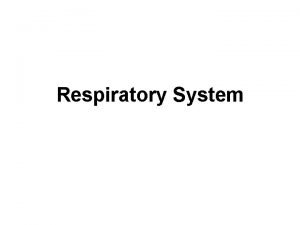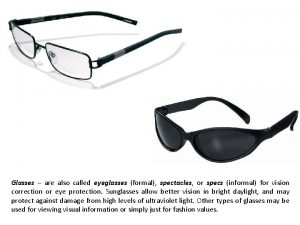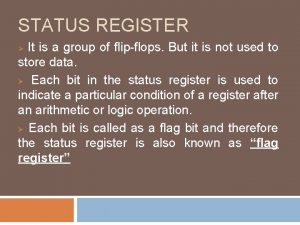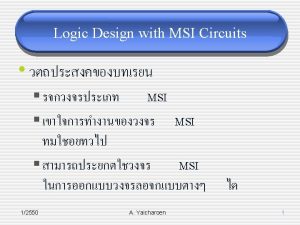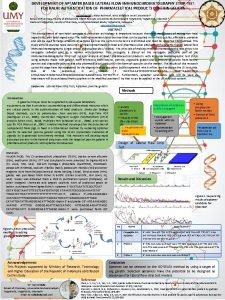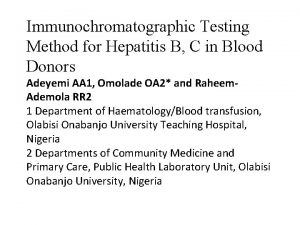Immunochromatography Introduction Immunochromatographic assays also called lateral flow






















- Slides: 22

Immunochromatography

Introduction � Immunochromatographic assays, also called lateral flow dipstick immunoassay or simply strip tests • Are simple devices intended to detect the presence (or absence) of a target analyte in sample (matrix) without the need for specialized and costly equipment. • A widely spread and well known application is the home pregnancy test.

Principle of Immunochromatography Kit: � The liquid sample is dropped on the sample pad, the antigen in the sample forms an immunocomplex with the antibody labeled with colloidal gold. � Its complex moves along with the liquid sample, and makes a contact with the antibody immobilized on the membrane, followed by forming an immunocomplxes with the immobilized antibody, resulting in generating a colored purple line

Principle of Immunochromatography Kit: � Appearance of red purple line on the membrane indicates the presence of antigen in interest in the sample. Since the liquid of the sample migrates through the membrane very fast, it makes it possible to detect the presence or absence of antigen within 15 minutes. � An Immunochromatographic unit is completed by attaching the sample pad at the end of the membrane.



Sample Pad � What do you need to know about your sample before? ◦ Variability of target molecule concentration (defines sample volume to be applied) ◦ Variability of sample composition, e. g. p. H (sample composition may have to be adjusted by sample pad pretreatment). ◦ Sample viscosity (limits density of the pad material) ◦ Unspecific interactions of your target with the pad material (defines pad blocking requirements). ◦ Unspecific interactions of the target with test line reagents (may require additional adjustments). ◦ Need of retention of particles contained in the sample (e. g. red blood cells).


Conjugate pad: � Typically, it is the physically smallest part in the lateral flow test. � Fulfills a diversity of functions: ◦ Absorbs the volume in which the detector conjugate is added to the pad. ◦ Does not interact with the conjugate. ◦ Maintains he conjugate integrity upon drying ◦ Maintains the conjugate in the dry state (can easily be more than a year at RT). ◦ Releases the conjugate easily and completely upon contact with the sample liquid. ◦ Allows for interaction between the detector reagents in the conjugate and the target in the sample.

The Analytical Membrane: � Typically, this is a “large pore sized “ nitrocellulose (NC) membrane. � The membrane are available in a very broad range of sample flow characteristics. � All NC membranes contain a surfactant, usually an anionic surfactant, that makes them hydrophilic.


The Wick � Its task is to soak the sample liquid and all reagents that have not been absorbed at the test and control lines. � It must prevent the backflow of this liquid into the drying membrane as long as possible. � Select a cotton paper with an absorption capacity that is much higher than the sample volume.

How they work: � Step 1: Sample placement ◦ To perform the test, a sample is placed on the sample pad at the end of the strip. ◦ The sample may be used alone as commonly done with urine or serum or whole blood or plasma compatible tests, or it may be mixed with a buffer specific to the test

� Step 2: Molecules solubilize ◦ with the addition of the sample, the detector molecules are solubilized. ◦ When solubilized the detector molecules mix with and bind to the analyte in the sample (if analytes is present).

� Step 3: Capillary action ◦ Then capillary action draws the fluid mixture up the sample pad and into the membrane. ◦ The sample/detector molecule mix continues to move up the membrane until it reaches the analyte capture molecule. ◦ In these lines a second (and third) antibody or antigen, immobilized as a thin stripe in the nitrocellulose will then capture the complexes if it is positive for the target analytes. ◦ The control line should always show as a visible line, otherwise the test is invalid and must be repeated. If the test is positive, a colored (typically pink or purple ) line develops along with the control line

� Step 4: Excess absorbed ◦ Excess buffer along with any reagent not captured at the test of control line will then moves into the absorbent wicking pad.


Advantages: 1. 2. 3. 4. 5. 6. 7. 8. 9. Can detect antigen or antibody Commercially available. Easy to perform Limited / no instrumentation. Single use, rapid test. User friendly format Very short time to get test result. Long-term stability over a wide range of climates Relatively inexpensive to make.

Disadvantages: 1. 2. Results are qualitative. Rapid tests can be less sensitive and less accurate.

Type of Lateral test (Format): � Strips � Cassette � Multi-devices � Midstream (h. CG and LH only).


Applications of Immunochromatographic assays: � It can be applied for multiple test platforms for liver, sexually transmitted diseases, cardiac markers, as well as women’s and men’s health (h. CG, VDRL, CMV, PSA, H. Pylori, Troponin I, TORCH, HIV, HBs Ag, HBV, HCV, RA, CRP, ASO, SLE, IM, salmonella Ig. M & Ig. G, …)
 What is immunochromatography test
What is immunochromatography test Is surface area and lateral area the same
Is surface area and lateral area the same Blind search
Blind search Citric acid cycle also called
Citric acid cycle also called Specification based technique
Specification based technique Pharynx
Pharynx A workbook is also called a
A workbook is also called a Primary decomposers are
Primary decomposers are Glasses also called eyeglasses (formal)
Glasses also called eyeglasses (formal) It is also called figurative language
It is also called figurative language Why are diphthongs known as gliding vowels
Why are diphthongs known as gliding vowels Citric acid cycle definition
Citric acid cycle definition Is spinning a locomotor movement
Is spinning a locomotor movement Alkanes list
Alkanes list Register is a group of
Register is a group of Short division bus stop method
Short division bus stop method Womb is also called
Womb is also called Raster scan system
Raster scan system Is also called as data selector.
Is also called as data selector. The circle graphs are commonly called
The circle graphs are commonly called Womb is also called
Womb is also called Formal equivalence meaning
Formal equivalence meaning Pg 112
Pg 112
